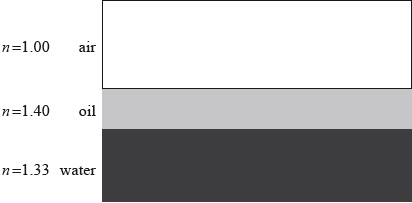| Date | November 2014 | Marks available | 2 | Reference code | 14N.3.HL.TZ0.15 |
| Level | Higher level | Paper | Paper 3 | Time zone | Time zone 0 |
| Command term | Explain | Question number | 15 | Adapted from | N/A |
Question
This question is about thin-film interference.
A thin film of oil of constant thickness floats on the surface of water. The refractive indices \(n\) of each material is shown on the diagram.

Explain why the film of oil appears to show coloured fringes.
When white light is normally incident on the surface of the oil, the film appears green to an observer. The wavelength of green light in air is 520 nm. Calculate the thickness of the film of oil.
Markscheme
the light reflects at the air:oil and the oil:water boundary; (can be shown on diagram)
light reflecting from the oil:water boundary interferes with the light reflecting from the air:oil boundary;
depending on the thickness of the oil, different frequencies show constructive/destructive interference (hence coloured fringes);
for constructive interference:
\(\left( {2nt = \left[ {m + \frac{1}{2}} \right]\lambda } \right)\)
\(t = \left[ {m + \frac{1}{2}} \right]\frac{\lambda }{{2n}}\)\(\,\,\,\)or\(\,\,\,\)\(\left[ {0 + \frac{1}{2}} \right]\frac{{520 \times {{10}^{ - 9}}}}{{2 \times 1.40}}\);
\(t = 93{\text{ nm}}\);
Examiners report
A large number of candidates did not explain two reflected rays, and that interference was dependent on the thickness of the oil film.
A large number of candidates did not explain two reflected rays, and that interference was dependent on the thickness of the oil film.

